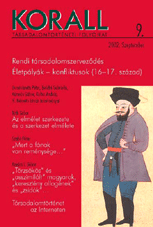Egy magyar főrend pályafutása császári udvarban. Batthyány Ádám (Bécs 1630–1659)
The Court Career of a Hungarian Aristocrat in the middle of the 17th Century Adam Batthyány in Vienna (1630–1659)
Author(s): András KoltaiSubject(s): History
Published by: KORALL Társadalomtörténeti Egyesület
Keywords: social history; court life; aristocracy; way of life; 17th century; Austria; Vienna
Summary/Abstract: The study follows the career of Count Adam Batthyány (1610-1659) in the courts of Emperors Ferdinand II and III. The survey of his story helps to explore the organization and operation of the court society, as well as the chances and connections of Hungarian aristocrats in the court, investigating how this system of connections worked and changed in the course of personal turning points and political metamorphoses. Adam Batthyány inherited large estates in Western Hungary from his Protestant parents. He lost his father when he was 15. The mentality of the Hungarian catholic aristocracy and the baroque culture of the imperial court impressed him so much, that he converted to Catholicism in 1629 and served from 1630 as a chamberlain Kammerherr of Ferdinand II. Marrying Aurora Formentini, a court dame Frauenzimmer of the Archduchesses in 1632, he established further important connections. With this background he became 1633 captain general of the district of Transdanubia (Dunántúl) and the borders against Kanizsa in Hungary. His military tasks and the need of the personal government of his estates obliged him however, to settle in Hungary and to spend less and less time in Vienna. In the 1630s the newlyweds were still regular participants of the court life, but in the 1640s and 1650s Adam Batthyány travelled only one or two times in a year to Vienna for some weeks and he spent a significant part even of this time with other Hungarian aristocrats. With these characteristics the career of Adam Batthyány seems to show similarity to the court attendance of other Hungarian Aristocrats, who usually also used their service in the imperial court to launch their military or administrative career in Hungary.
Journal: Korall - Társadalomtörténeti folyóirat
- Issue Year: 2002
- Issue No: 9
- Page Range: 55-78
- Page Count: 55
- Language: Hungarian

